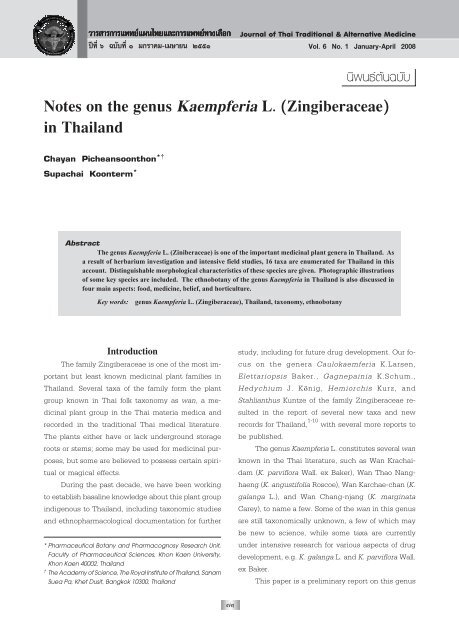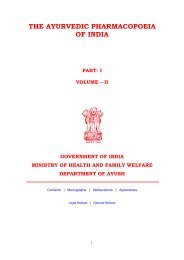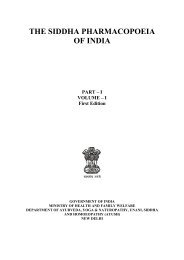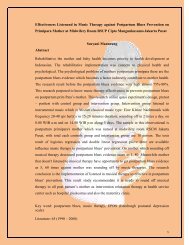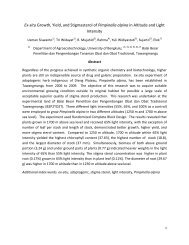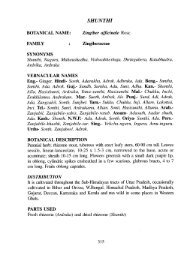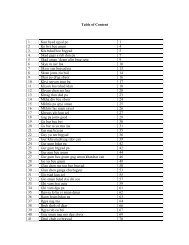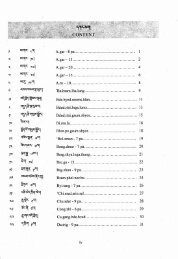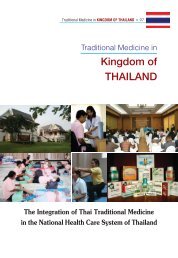Notes on the genus Kaempferia L. (Zingiberaceae) in Thailand
Notes on the genus Kaempferia L. (Zingiberaceae) in Thailand
Notes on the genus Kaempferia L. (Zingiberaceae) in Thailand
Create successful ePaper yourself
Turn your PDF publications into a flip-book with our unique Google optimized e-Paper software.
«“√ «“√ “√°“√·æ∑¬å·ºπ‰∑¬·≈–°“√·æ∑¬å∑“߇≈◊Õ°<br />
“√°“√·æ∑¬å·ºπ‰∑¬·≈–°“√·æ∑¬å∑“߇≈◊Õ° Journal of Thai Traditi<strong>on</strong>al & Alternative Medic<strong>in</strong>e<br />
Journal of Thai ªï∑’ Ë Traditi<strong>on</strong>al ˆ ©∫—∫∑’ Ë Ò & ¡°√“§¡-‡¡…“¬π Alternative Medic<strong>in</strong>e ÚııÒ<br />
Vol. 6 Vol. No. 6 No. 1 1January-April January - April 2008<br />
<str<strong>on</strong>g>Notes</str<strong>on</strong>g> <strong>on</strong> <strong>the</strong> <strong>genus</strong> <strong>Kaempferia</strong> L. (<strong>Z<strong>in</strong>giberaceae</strong>)<br />
<strong>in</strong> <strong>Thailand</strong><br />
Chayan Picheanso<strong>on</strong>th<strong>on</strong> *†<br />
Supachai Ko<strong>on</strong>term *<br />
Abstract The <strong>genus</strong> <strong>Kaempferia</strong> L. (Z<strong>in</strong>iberaceae) is <strong>on</strong>e of <strong>the</strong> important medic<strong>in</strong>al plant genera <strong>in</strong> <strong>Thailand</strong>. As<br />
a result of herbarium <strong>in</strong>vestigati<strong>on</strong> and <strong>in</strong>tensive field studies, 16 taxa are enumerated for <strong>Thailand</strong> <strong>in</strong> this<br />
account. Dist<strong>in</strong>guishable morphological characteristics of <strong>the</strong>se species are given. Photographic illustrati<strong>on</strong>s<br />
of some key species are <strong>in</strong>cluded. The ethnobotany of <strong>the</strong> <strong>genus</strong> <strong>Kaempferia</strong> <strong>in</strong> <strong>Thailand</strong> is also discussed <strong>in</strong><br />
four ma<strong>in</strong> aspects: food, medic<strong>in</strong>e, belief, and horticulture.<br />
Key words: <strong>genus</strong> <strong>Kaempferia</strong> L. (<strong>Z<strong>in</strong>giberaceae</strong>), <strong>Thailand</strong>, tax<strong>on</strong>omy, ethnobotany<br />
Introducti<strong>on</strong><br />
The family <strong>Z<strong>in</strong>giberaceae</strong> is <strong>on</strong>e of <strong>the</strong> most important<br />
but least known medic<strong>in</strong>al plant families <strong>in</strong><br />
<strong>Thailand</strong>. Several taxa of <strong>the</strong> family form <strong>the</strong> plant<br />
group known <strong>in</strong> Thai folk tax<strong>on</strong>omy as wan, a medic<strong>in</strong>al<br />
plant group <strong>in</strong> <strong>the</strong> Thai materia medica and<br />
recorded <strong>in</strong> <strong>the</strong> traditi<strong>on</strong>al Thai medical literature.<br />
The plants ei<strong>the</strong>r have or lack underground storage<br />
roots or stems; some may be used for medic<strong>in</strong>al purposes,<br />
but some are believed to possess certa<strong>in</strong> spiritual<br />
or magical effects.<br />
Dur<strong>in</strong>g <strong>the</strong> past decade, we have been work<strong>in</strong>g<br />
to establish basal<strong>in</strong>e knowledge about this plant group<br />
<strong>in</strong>digenous to <strong>Thailand</strong>, <strong>in</strong>clud<strong>in</strong>g tax<strong>on</strong>omic studies<br />
and ethnopharmacological documentati<strong>on</strong> for fur<strong>the</strong>r<br />
* Pharmaceutical Botany and Pharmacognosy Research Unit,<br />
Faculty of Pharmaceutical Sciences, Kh<strong>on</strong> Kaen University,<br />
Kh<strong>on</strong> Kaen 40002, <strong>Thailand</strong><br />
† The Academy of Science, The Royal Institute of <strong>Thailand</strong>, Sanam<br />
Suea Pa, Khet Dusit, Bangkok 10300, <strong>Thailand</strong><br />
˜Û<br />
π‘æπ∏åµâπ©∫—∫<br />
study, <strong>in</strong>clud<strong>in</strong>g for future drug development. Our focus<br />
<strong>on</strong> <strong>the</strong> genera Caulokaemferia K.Larsen,<br />
Elettariopsis Baker., Gagnepa<strong>in</strong>ia K.Schum.,<br />
Hedychium J. König, Hemiorchis Kurz, and<br />
Stahlianthus Kuntze of <strong>the</strong> family <strong>Z<strong>in</strong>giberaceae</strong> resulted<br />
<strong>in</strong> <strong>the</strong> report of several new taxa and new<br />
records for <strong>Thailand</strong>, 1-10 with several more reports to<br />
be published.<br />
The <strong>genus</strong> <strong>Kaempferia</strong> L. c<strong>on</strong>stitutes several wan<br />
known <strong>in</strong> <strong>the</strong> Thai literature, such as Wan Krachaidam<br />
(K. parviflora Wall. ex Baker), Wan Thao Nanghaeng<br />
(K. angustifolia Roscoe), Wan Karchae-chan (K.<br />
galanga L.), and Wan Chang-njang (K. marg<strong>in</strong>ata<br />
Carey), to name a few. Some of <strong>the</strong> wan <strong>in</strong> this <strong>genus</strong><br />
are still tax<strong>on</strong>omically unknown, a few of which may<br />
be new to science, while some taxa are currently<br />
under <strong>in</strong>tensive research for various aspects of drug<br />
development, e.g. K. galanga L. and K. parviflora Wall.<br />
ex Baker.<br />
This paper is a prelim<strong>in</strong>ary report <strong>on</strong> this <strong>genus</strong>
˜Ù<br />
«“√ “√°“√·æ∑¬å·ºπ‰∑¬·≈–°“√·æ∑¬å∑“߇≈◊Õ° ªï∑’ Ë ˆ©∫—∫∑’ Ë Ò ¡°√“§¡ - ‡¡…“¬π ÚııÒ<br />
<strong>in</strong> two ma<strong>in</strong> aspects, tax<strong>on</strong>omy and ethnobotany, result<strong>in</strong>g<br />
from our specimen-based <strong>in</strong>vestigati<strong>on</strong> and<br />
<strong>in</strong>tensive field research throughout <strong>Thailand</strong> and Laos,<br />
comb<strong>in</strong>ed with previous reports <strong>on</strong> <strong>the</strong> <strong>genus</strong>. The<br />
objective of <strong>the</strong> paper is to set up <strong>the</strong> most up-todate<br />
basel<strong>in</strong>e <strong>in</strong>formati<strong>on</strong> <strong>on</strong> <strong>the</strong> <strong>genus</strong> <strong>Kaempferia</strong><br />
L. for future studies <strong>on</strong> all aspects, <strong>in</strong>clud<strong>in</strong>g new<br />
drug development.<br />
Tax<strong>on</strong>omy<br />
History<br />
The <strong>genus</strong> <strong>Kaempferia</strong> L. was established <strong>in</strong> 1753<br />
with two species: K. galanga L. and K. rotunda L. 11,12<br />
The former tax<strong>on</strong> was first described by a German<br />
botanist, Engelbert Kaempfer (1651-1716), and was<br />
chosen to be <strong>the</strong> lectotype for <strong>the</strong> <strong>genus</strong> by Hitchcock<br />
and Green, and by Phillips. 13,14 S<strong>in</strong>ce <strong>the</strong>n, several<br />
new taxa from Asia and Africa have been described.<br />
Baker (1890) listed four subgenera with a total of<br />
22 species <strong>in</strong> his account <strong>on</strong> <strong>the</strong> <strong>genus</strong> <strong>Kaempferia</strong> L.<br />
for British India: S<strong>in</strong>corus Horan. (12 species),<br />
Protanthium Horan. (2 species), <strong>on</strong>olophus Wall. (7<br />
species), and Stachyan<strong>the</strong>sis Benth. (1 species). 15<br />
However, some of <strong>the</strong>se taxa have currently been<br />
transferred to o<strong>the</strong>r related genera, i.e. Boesenbergia<br />
Kuntze, Camptandra Ridl., Caulokaempferia K.Larsen,<br />
and Stahlianthus Kuntze. Much later, Kam (1980) made<br />
<strong>the</strong> exemplary and lucid analyses <strong>on</strong> <strong>the</strong> tax<strong>on</strong>omic<br />
history of <strong>the</strong> <strong>genus</strong> and po<strong>in</strong>ted out that <strong>the</strong> sub<strong>genus</strong><br />
S<strong>in</strong>corus (Horan.) Baker <strong>in</strong>cludes <strong>the</strong> generic type,<br />
and, <strong>the</strong>refore, should become sub<strong>genus</strong> <strong>Kaempferia</strong>. 14<br />
She tentatively recognized three groups as secti<strong>on</strong>s<br />
of Asiatic species: Sect. <strong>Kaempferia</strong> (<strong>the</strong> K. galanga<br />
group), Sect. Protanthium (Horan.) Benth. (<strong>the</strong> K. rotunda<br />
group), and Sect. Stachyan<strong>the</strong>is Benth., with<br />
<strong>on</strong>ly <strong>on</strong>e tax<strong>on</strong>, K. scaposa (Dalz.) Benth. 14<br />
In his account, Gagnepa<strong>in</strong> (1908) enumerated 13<br />
taxa for Indoch<strong>in</strong>a. 16 Although most of his species<br />
are currently accepted, three have been placed under<br />
a different <strong>genus</strong>, Boesenbergia Kuntze. In 1924, Ridley<br />
reported five species <strong>in</strong> his treatment of <strong>the</strong> Malay<br />
Penn<strong>in</strong>sula. 17 Holttum (1950) accepted four of Ridleyûs<br />
accounts, but transferred K. cyanescens Ridl. to<br />
Haniffia cyanescens (Ridl.) Holtt. 18<br />
Generic features<br />
Schumann (1903) c<strong>on</strong>sidered <strong>the</strong> trilocular ovary<br />
with axile placentati<strong>on</strong> a key character of <strong>the</strong> <strong>genus</strong><br />
<strong>Kaempferia</strong> L. 19 However, this character is comm<strong>on</strong><br />
to o<strong>the</strong>r genera and seems to be variable with<strong>in</strong> <strong>the</strong><br />
<strong>genus</strong>. 14 Therefore, a comb<strong>in</strong>ati<strong>on</strong> of several diagnostic<br />
characteristics, both vegetative and floral morphology,<br />
is essential for tax<strong>on</strong>omic decisi<strong>on</strong> at any<br />
species level.<br />
The vegetative characters of taxa found <strong>in</strong> Sou<strong>the</strong>ast<br />
Asia are often associated with <strong>the</strong> fleshy rhizomes,<br />
usually short, with several roots <strong>in</strong> a fascicle.<br />
The roots of some species, particularly those with<br />
<strong>in</strong>florescence separated from and preced<strong>in</strong>g leafshoots,<br />
are fibrous with term<strong>in</strong>al globular to fusiform<br />
storage tubers. Leaves range from <strong>on</strong>e to a few; <strong>the</strong>y<br />
are filiform to very broad, ris<strong>in</strong>g from <strong>the</strong> rhizomes,<br />
usually with keeled shea<strong>the</strong>s, short to l<strong>on</strong>g petioles,<br />
small, <strong>in</strong>c<strong>on</strong>spicuous, or without ligules. One to a few<br />
large ovate to orbicular prostrate or accumbent leaves<br />
are characteristic of some taxa, e.g. K. galanga L., K.<br />
laotica Gagnep., K. marg<strong>in</strong>ata Carey. Narrowly l<strong>in</strong>ear<br />
to filiform leaf blades are unique to a certa<strong>in</strong> group,<br />
i.e., K. fissa Gagnep., K. fallax Gagnep., and K. filifolia<br />
K. Larsen. However, from our <strong>in</strong>tensive studies <strong>on</strong><br />
<strong>the</strong> herbarium specimens available and our <strong>in</strong>vestigati<strong>on</strong><br />
of liv<strong>in</strong>g specimens, <strong>the</strong>se characters can vary<br />
greatly with<strong>in</strong> a species.<br />
The <strong>in</strong>florescence of all species found <strong>in</strong> <strong>Thailand</strong><br />
is ei<strong>the</strong>r separated from (<strong>in</strong> all taxa preced<strong>in</strong>g<br />
<strong>the</strong> appearance of <strong>the</strong> leaf-shoots), or term<strong>in</strong>al <strong>on</strong> and<br />
c<strong>on</strong>temporaneous with <strong>the</strong> leaf-shoots. The term<strong>in</strong>al<br />
<strong>in</strong>florescence often forms a pedunculate head, and all<br />
its primary bracts are always fertile. However, <strong>the</strong><br />
radical <strong>in</strong>florescence is ei<strong>the</strong>r sessile or very shortly<br />
pedunculated, with 2-4 sterile sheath<strong>in</strong>g bracts. The<br />
n<strong>on</strong>-tubular primary bract is always accompanied by<br />
a shortly bilobed or bilobed-to-<strong>the</strong>-base bracteole, and<br />
subtends <strong>on</strong>ly <strong>on</strong>e flower.<br />
A comb<strong>in</strong>ati<strong>on</strong> of <strong>the</strong> overall floral morphology is<br />
characteristic of <strong>the</strong> Asiatic <strong>Kaempferia</strong> species. The<br />
labellum is separated from <strong>the</strong> lateral stam<strong>in</strong>odes al-
Journal of Thai Traditi<strong>on</strong>al & Alternative Medic<strong>in</strong>e Vol. 6 No. 1 January - April 2008 ˜ı<br />
most to <strong>the</strong> base, and is often deeply bilobed, except<br />
that of K. parviflora Wall. ex Baker. The lateral<br />
stam<strong>in</strong>odes are always petaloid and <strong>the</strong> an<strong>the</strong>r crest<br />
is always c<strong>on</strong>spicuous and could be entire or dentate,<br />
straight or reflexed, and narrow or orbicular.<br />
Moreover, <strong>the</strong> stigma is always cup-shaped with ciliated<br />
rims and <strong>the</strong> stylodial glands are paired and<br />
needle-like.<br />
However, morphological features can be greatly<br />
variable, even with<strong>in</strong> <strong>the</strong> same tax<strong>on</strong>. Therefore, until<br />
<strong>the</strong> range of character variati<strong>on</strong> of <strong>the</strong>se generic features<br />
is fully understood, a s<strong>in</strong>gle diagnostic character<br />
cannot be used for tax<strong>on</strong>omic decisi<strong>on</strong>-mak<strong>in</strong>g.<br />
Relati<strong>on</strong>ship<br />
As po<strong>in</strong>ted out by Holttum (1971), <strong>the</strong> <strong>genus</strong><br />
<strong>Kaempferia</strong> L. is morphologically closely related to<br />
<strong>the</strong> genera Boesenbergia O.Kuntze and Scaphochlamys<br />
Baker. 18 Both <strong>Kaempferia</strong> and Boesengergia possess<br />
<strong>on</strong>e flower <strong>in</strong> <strong>the</strong> axil of each bract, with <strong>on</strong>e or two<br />
bracteoles. In c<strong>on</strong>trast with <strong>the</strong> not-two-ranked bract<br />
arrangement and <strong>the</strong> often flat and bilobed labella of<br />
<strong>the</strong> <strong>Kaempferia</strong>, those of <strong>the</strong> Boesenbergia are tworanked,<br />
and <strong>the</strong> labella often saccate with <strong>the</strong> distal<br />
part often be<strong>in</strong>g entire or crenate, and often reddish<br />
toward <strong>the</strong> apex. These characters clearly are dist<strong>in</strong>ct<br />
enough to differentiate <strong>the</strong> two genera. 18<br />
The rhizomes of <strong>the</strong> <strong>Kaempferia</strong> are ei<strong>the</strong>r short<br />
fleshy elements or fleshy tuber-bear<strong>in</strong>g roots, while<br />
those of <strong>the</strong> Scaphochlamys are less fleshy, often l<strong>on</strong>g<br />
creep<strong>in</strong>g. 18 The short and compact <strong>in</strong>florescence of<br />
<strong>the</strong> <strong>Kaempferia</strong> comprises <strong>on</strong>e flower to each bract.<br />
The flower is accompanied by a more or less deeply<br />
bilobe bracteole or by two narrow separated bracteoles.<br />
The labellum is deeply bilobed (except K. parviflora<br />
Wall. ex. Baker), <strong>the</strong> an<strong>the</strong>r crest is often large and<br />
petaloid, and <strong>the</strong> filament always very short, whereas<br />
those <strong>in</strong>florescences of <strong>the</strong> Scaphochlamys c<strong>on</strong>sist of<br />
several flowers to each bract; however, <strong>the</strong> labellum<br />
is never so deeply bilobed, and <strong>the</strong> filament is always<br />
present. 18<br />
The <strong>Kaempferia</strong> L. is also related to <strong>the</strong> <strong>genus</strong><br />
Cornukaempferia J.Mood & K.Larsen <strong>in</strong> general habit. 25<br />
However, <strong>the</strong> <strong>Kaempferia</strong> always produces large, flat,<br />
and petaloid an<strong>the</strong>r crests, never çZ<strong>in</strong>giber-likeé, as<br />
<strong>in</strong> <strong>the</strong> <strong>genus</strong> Z<strong>in</strong>giber. Also, <strong>the</strong> <strong>Kaempferia</strong> is also<br />
dist<strong>in</strong>guishable by its more or less bilobe bracteoles,<br />
while <strong>the</strong> bracteole is absent <strong>in</strong> <strong>the</strong> Cornukaempferia.<br />
The Thai Taxa<br />
Of <strong>the</strong> 15 taxa accounted for <strong>in</strong> <strong>Thailand</strong>, 20,21 six<br />
were also reported for Ch<strong>in</strong>a. 22 K. candida Wall. was<br />
later reported to also be found <strong>in</strong> <strong>Thailand</strong> 23 and a<br />
new tax<strong>on</strong>, K. grandifolia Saensouk & Jenjitt., was<br />
also added. 24 All currently known Thai taxa can be<br />
divided <strong>in</strong>to two groups, <strong>the</strong> K. galanga-group and<br />
<strong>the</strong> K. rotunda-group. The former group is characterized<br />
by a short multiflorous <strong>in</strong>florescence that appears<br />
earlier before <strong>the</strong> leaves, while <strong>the</strong> latter group <strong>in</strong>cludes<br />
species <strong>in</strong> which <strong>the</strong> <strong>in</strong>florescence has few<br />
flowers and is term<strong>in</strong>al <strong>on</strong> <strong>the</strong> leaf-shoots. In <strong>Thailand</strong>,<br />
three species, K. candida Wall, K. grandifolia<br />
Saensouk & Jenjitt., and K. rotunda L., represent <strong>the</strong><br />
former group. To set up basel<strong>in</strong>e <strong>in</strong>formati<strong>on</strong> <strong>on</strong> <strong>the</strong><br />
<strong>genus</strong> for fur<strong>the</strong>r studies, all <strong>the</strong> Thai taxa will be<br />
discussed here briefly.<br />
1. K. angustifolia Roscoe <strong>in</strong> Trans. L<strong>in</strong>n. Soc. 8: 351.<br />
1807; M<strong>on</strong>andr. Pl. t. 04. 1828; Roxb., Fl. Ind. 1: 17.<br />
1820; Horan., M<strong>on</strong>ogr.: 21. 1862; Bak. <strong>in</strong> Hook., Fl. Br.<br />
Ind. 6: 219. 1894; Schum. <strong>in</strong> Engl., Pflanzenr. 4(46), 20<br />
Heft: 86. 1904; Sirirugsa <strong>in</strong> Nord. J. Bot. 9: 259. 1989 &<br />
<strong>in</strong> Thai For. Bull. (Bot.) 19: 8-9. 1992.––K. roxburghiana<br />
Schult., Mant. 1: 83. 1822.––K. undulata Teysm. et<br />
B<strong>in</strong>n. <strong>in</strong> Neederl. Kruidk. Arch. 3:391. 1855. (n<strong>on</strong> L<strong>in</strong>k<br />
<strong>in</strong> Dietr. Syn.); Ic<strong>on</strong>. T. 376. 1914. Plate II:5.<br />
Type: Bangladesh, Roxburgh s.n. (holotype K)<br />
This medic<strong>in</strong>al tax<strong>on</strong> is a variable species with<br />
<strong>the</strong> leaves rang<strong>in</strong>g from small (about 4 × 1 cm) to<br />
quite large (14-20 × 4-10 cm). The dist<strong>in</strong>guishable<br />
characteristic of this species are <strong>the</strong> erect ellipticobl<strong>on</strong>g<br />
leaves with undulate marg<strong>in</strong>s, <strong>the</strong> <strong>in</strong>florescence<br />
borne <strong>in</strong> <strong>the</strong> two <strong>in</strong>nermost leaf-sheaths, <strong>the</strong><br />
quadrangulate and white (with a purple blotch at <strong>the</strong><br />
center) an<strong>the</strong>r crest (about 3.5 cm l<strong>on</strong>g) with a bifid<br />
apex, and <strong>the</strong> glabrous ovary. The labella of this species<br />
are lilac with purple blotch at <strong>the</strong> center, obo-
˜ˆ<br />
«“√ “√°“√·æ∑¬å·ºπ‰∑¬·≈–°“√·æ∑¬å∑“߇≈◊Õ° ªï∑’ Ë ˆ©∫—∫∑’ Ë Ò ¡°√“§¡ - ‡¡…“¬π ÚııÒ<br />
Fig. 1 K. angustifolia Roscoe, show<strong>in</strong>g <strong>the</strong> plant habit, leaves and flower.<br />
Fig. 2 K. candida Wall., show<strong>in</strong>g <strong>the</strong> rhizome, roots, and an<br />
<strong>in</strong>florescence.<br />
Fig. 3 K. candida Wall., show<strong>in</strong>g a rhizome, roots, and an <strong>in</strong>florescence<br />
and details of <strong>the</strong> flowers.
Journal of Thai Traditi<strong>on</strong>al & Alternative Medic<strong>in</strong>e Vol. 6 No. 1 January - April 2008 ˜˜<br />
vate and bilobe (<strong>in</strong> <strong>the</strong> middle), while <strong>the</strong> stam<strong>in</strong>odes<br />
are white, obovate-obl<strong>on</strong>g or obl<strong>on</strong>g.<br />
This species can be found <strong>in</strong> (its natural habitat)<br />
<strong>in</strong> Ub<strong>on</strong> Ratchathani Prov<strong>in</strong>ce of <strong>Thailand</strong>, but it is<br />
wildly cultivated, especially <strong>in</strong> nor<strong>the</strong>astern <strong>Thailand</strong>,<br />
for spiritual and medic<strong>in</strong>al purposes. The cultivated<br />
<strong>on</strong>es seem to be much larger <strong>in</strong> habit.<br />
2. K. candida Wall., Pl. Asiat. Rar. 1: 47, t. 56. 1830;<br />
Bak. <strong>in</strong> Hook., Fl. Br. Ind. 6: 222. 1894; Schum. <strong>in</strong><br />
Engl., Pflanzenr. 4(46), 20 Heft: 87. 1904; Gagnep. <strong>in</strong><br />
Lecomte, Fl. Gén. I.-C. 6: 47. 1908; Jenjitt. & K.Larsen<br />
<strong>in</strong> Thai For. Bull. (Bot.) 28: 45-46, figs. 1-2. 2000; T.L.Wu<br />
& K.Larsen <strong>in</strong> Z.L. Wu & PH. Raven, Fl. Ch<strong>in</strong>a 24:<br />
369. 2000.<br />
Type: Myanmar, Wallich 6585 (holotype K)<br />
This edible tax<strong>on</strong> can be easily recognized by<br />
its radical <strong>in</strong>florescences aris<strong>in</strong>g from <strong>the</strong> rhizomes<br />
before <strong>the</strong> appearance of <strong>the</strong> leaf-shoot, white erect<br />
lateral stam<strong>in</strong>odes with yellow patches at <strong>the</strong> base,<br />
and white reflexed labellum apically two-lobed for<br />
about <strong>on</strong>e-third its length, with two yellow l<strong>in</strong>es at<br />
<strong>the</strong> center. The <strong>in</strong>florescences appear from as early<br />
as March until late July.<br />
This species is distributed from Myanmar and<br />
Ch<strong>in</strong>a (southwest Yunnan) through Vietnam, Laos and<br />
Cambodia. 22 In <strong>Thailand</strong> it was recorded <strong>in</strong><br />
Kanchanaburi Prov<strong>in</strong>ce. 23 However, <strong>the</strong> authors also<br />
found this species <strong>in</strong> Tak, Mae H<strong>on</strong>g S<strong>on</strong>, and Chiang<br />
Mai.<br />
3. K. elegans Wall. ex Baker. <strong>in</strong> Hooker, Fl. Br. Ind.<br />
6:222. 1890; Schum. <strong>in</strong> Engl., Pflanzenr. 4(46), 20 Heft:<br />
82. 1904; Ridl., Fl. Mal. Pen. 4:245. 1924; Holtt. <strong>in</strong> Gard.<br />
Bull. S<strong>in</strong>g. 13:123. 1950; Chung, Lime. Fl. Mal. 2: 711.<br />
1973; Sirirugsa <strong>in</strong> Nord. J. Bot. 9: 259. 1989 & <strong>in</strong> Thai<br />
For. Bull. (Bot.) 19: 5-6. 1992; T.L.Wu & K.Larsen <strong>in</strong><br />
Z.L.Wu & PH. Raven, Fl. Ch<strong>in</strong>a 24: 369. 2000.––K.<br />
crawfurdii Wall., Cat. <strong>in</strong> ed.–M<strong>on</strong>olophus elegans Wall.,<br />
Pl. Asiat. Rar. 1:24. t. 27. 1830; Horan., M<strong>on</strong>ogr. :22.1862.<br />
––K. pulchra Ridl. <strong>in</strong> J. Str. Br. Asiat. Soc. Bengal 32:<br />
107. 1899.<br />
Type: Myanmar, tenasserim, Wallich 6593 (Lectotype<br />
K)<br />
This beautiful species is recognized here as c<strong>on</strong>specific<br />
to K. pulchra Ridl. It is also variable <strong>in</strong> plant<br />
habit. However, it can be readily dist<strong>in</strong>guished by<br />
its erect leaf blades, with 1-10 cm l<strong>on</strong>g petioles and<br />
<strong>the</strong> triangular (2-5 mm l<strong>on</strong>g) ligules, l<strong>on</strong>g hairy<br />
pedunculated (1-20 cm) <strong>in</strong>florescences, and violet<br />
flowers with large orbicular to obl<strong>on</strong>g crests with<br />
variable apices.<br />
This tax<strong>on</strong> is also widely distributed: from India<br />
and Myanmar to <strong>Thailand</strong> and Pen<strong>in</strong>sular Malaysia.<br />
It can be found from <strong>the</strong> nor<strong>the</strong>rn part of <strong>the</strong> country<br />
to Pen<strong>in</strong>sular <strong>Thailand</strong>, often al<strong>on</strong>g <strong>the</strong> streams <strong>on</strong><br />
limest<strong>on</strong>e boulders <strong>in</strong> mixed deciduous forests. This<br />
species is widely cultivated <strong>in</strong> <strong>Thailand</strong> for horticultural<br />
purposes. The leaves are edible and <strong>the</strong> rhizomes<br />
are medic<strong>in</strong>al.<br />
4. K. fallax Gagnep. <strong>in</strong> Bull. Soc. Bot. Fr. 4. ser. 3:<br />
259. 1903; Schum. <strong>in</strong> Engl., Pflanzenr. 4(46), 20 Heft:<br />
437. 1904; Gagnep. <strong>in</strong> Lecomte, Fl. Gén. I.-C. 6: 48.<br />
1908; Sirirugsa <strong>in</strong> Nord. J. Bot. 9: 259. 1989 & <strong>in</strong> Thai<br />
For. Bull. (Bot.) 19: 4-5. 1992.<br />
Type: Laos, Harmand s.n. (holotype P)<br />
This tax<strong>on</strong> can be dist<strong>in</strong>guished by its 2-4 l<strong>in</strong>ear<br />
leaves (not more than 1 cm wide), sessile <strong>in</strong>florescences<br />
with pure white, night-bloom<strong>in</strong>g flowers, obovate<br />
lateral stam<strong>in</strong>odes, deeply bilobed lips, and quadrate<br />
bilobed crests. It is closely related to K. fissa<br />
Gagnep. and K. filifolia K.Larsen. <strong>in</strong> plant habit and<br />
its white flowers. However, <strong>the</strong> leaves of <strong>the</strong> latter<br />
two taxa are filiformis and <strong>the</strong> an<strong>the</strong>r crests are ei<strong>the</strong>r<br />
square or rectangular with apices rang<strong>in</strong>g from<br />
straight to bifurcate.<br />
This species can be found thoughout sou<strong>the</strong>rn<br />
Laos. It often grows <strong>in</strong> sandy soils near <strong>the</strong> banks of<br />
rivers or <strong>in</strong> paddy fields <strong>in</strong> Nakh<strong>on</strong> Phanom,<br />
Ub<strong>on</strong>ratchathani and Amnat Charoen prov<strong>in</strong>ces <strong>in</strong><br />
nor<strong>the</strong>astern <strong>Thailand</strong>.<br />
5. K. filifolia K.Larsen <strong>in</strong> Bot. Tidsskr. 58: 201. 1962;<br />
Sirirugsa <strong>in</strong> Nord. J. Bot. 9: 259. 1989 & <strong>in</strong> Thai For.
˜¯<br />
«“√ “√°“√·æ∑¬å·ºπ‰∑¬·≈–°“√·æ∑¬å∑“߇≈◊Õ° ªï∑’ Ë ˆ©∫—∫∑’ Ë Ò ¡°√“§¡ - ‡¡…“¬π ÚııÒ<br />
Fig. 4 K. elegans Wall. ex Baker, show<strong>in</strong>g <strong>the</strong> plant habit, flowers and leaves.<br />
Fig. 5 K. elegans Wall. ex Baker, show<strong>in</strong>g detail of <strong>the</strong> flowers.
Journal of Thai Traditi<strong>on</strong>al & Alternative Medic<strong>in</strong>e Vol. 6 No. 1 January - April 2008 ˜˘<br />
Fig. 6 K. fallax Gagnep., show<strong>in</strong>g <strong>the</strong> plant habit and a flower. Fig. 7 K. fallax Gagnep., show<strong>in</strong>g detail of <strong>the</strong> flower.<br />
Fig. 8 K. filifolia K.Larsen, show<strong>in</strong>g <strong>the</strong> plant habit and a flower. Fig. 9 K. filifolia K.Larsen, show<strong>in</strong>g detail of <strong>the</strong> flower.
¯apple<br />
«“√ “√°“√·æ∑¬å·ºπ‰∑¬·≈–°“√·æ∑¬å∑“߇≈◊Õ° ªï∑’ Ë ˆ©∫—∫∑’ Ë Ò ¡°√“§¡ - ‡¡…“¬π ÚııÒ<br />
Bull. (Bot.) 19: 5. 1992.<br />
Type: <strong>Thailand</strong>, Phu Wat (Mukdahan Prov<strong>in</strong>ce), Kerr<br />
21500 (holotype K)<br />
This tax<strong>on</strong> was described from <strong>the</strong> specimen<br />
collected by A.F.G. Kerr <strong>in</strong> 1932 from çPu Wat (Nakawn<br />
Panom)é, which is nowadays Phu Wat of Mukdahan<br />
Prov<strong>in</strong>ce <strong>in</strong> nor<strong>the</strong>astern <strong>Thailand</strong>. The type specimen<br />
was described as closely related to K. fissa<br />
Gagnep. and K. fallax Gagnep, but it differs <strong>in</strong> <strong>the</strong><br />
larger habits and an<strong>the</strong>r crests. All three taxa possess<br />
pure white, night-bloom<strong>in</strong>g flowers. The c<strong>on</strong>nective<br />
appendage of this tax<strong>on</strong> may be described as rectangular<br />
with bifurcate apex, while those of <strong>the</strong> two latter<br />
species are short bifurcate and square respectively.<br />
However, <strong>the</strong>se characters, which are used for<br />
tax<strong>on</strong>omic decisi<strong>on</strong>-mak<strong>in</strong>g, are variable, especially<br />
<strong>the</strong> length of <strong>the</strong> leaves and corolla tubes.<br />
Dur<strong>in</strong>g <strong>the</strong> past few years, <strong>the</strong> authors have made<br />
several visits to <strong>the</strong> sites of this tax<strong>on</strong> <strong>in</strong> Phu Phan<br />
Nati<strong>on</strong>al Park (Sak<strong>on</strong> Nakh<strong>on</strong> Prov<strong>in</strong>ce), Phu Wat (type<br />
locati<strong>on</strong>, formerly Nakh<strong>on</strong> Phanom, but now Mukdahan<br />
Prov<strong>in</strong>ce), Kh<strong>on</strong>g Chiam and Sir<strong>in</strong>dhorn Districts<br />
(Ub<strong>on</strong>ratchathani Prov<strong>in</strong>ce), <strong>in</strong>clud<strong>in</strong>g several o<strong>the</strong>r<br />
locati<strong>on</strong>s <strong>in</strong> sou<strong>the</strong>rn Laos, to m<strong>on</strong>itor and study <strong>the</strong><br />
liv<strong>in</strong>g populati<strong>on</strong>s. At this stage we suspect that this<br />
species may be c<strong>on</strong>specific to K. fissa Gagnep. A<br />
molecular study to c<strong>on</strong>firm our hypo<strong>the</strong>sis is <strong>in</strong><br />
progress.<br />
6. K. galanga L., Sp. Pl.: 2. 1753; Roxb., Pl. Ind. 1: 5.<br />
1820; Bak. <strong>in</strong> Hook., Fl. Br. Ind. 6: 218. 1890; Schum.<br />
<strong>in</strong> Engl., Pflanzenr. 4(46), 20 Heft: 77. 1904; Gagnep.<br />
<strong>in</strong> Lecomte, Fl. Gén. I.-C. 6: 45. 1908; Ridl., Fl. Mal.<br />
Pen. 4:245. 1924; Holtt. <strong>in</strong> Gard. Bull. S<strong>in</strong>g. 13:117.<br />
1950; Larsen <strong>in</strong> Bot. Tidsskr. 58: 201. 1962; Chung,<br />
Lime. Fl. Mal. 2: 703. 1973; Burtt & Smith <strong>in</strong><br />
Dassanayake, Fl. Cey. 4: 508. 1983; Sirirugsa <strong>in</strong> Nord.<br />
J. Bot. 9: 259. 1989 & <strong>in</strong> Thai For. Bull. (Bot.) 19: 11.<br />
1992; T.L.Wu & K.Larsen <strong>in</strong> Z.L.Wu & PH. Raven, Fl.<br />
Ch<strong>in</strong>a 24: 369. 2000.––K. sessilis König <strong>in</strong> Retz., Obs.<br />
3: 67. 1783.––K. humilis Salisb., Prodr. 6. 1796.––K.<br />
plantag<strong>in</strong>ifolia Salisb. <strong>in</strong> Trans. Hort. Soc. 1: 286. 1808.<br />
Type: probably Hort. Cliff.<br />
This generic type species is <strong>on</strong>e of <strong>the</strong> important<br />
medic<strong>in</strong>al plants used <strong>in</strong> Thai traditi<strong>on</strong>al medic<strong>in</strong>e.<br />
It can be readily dist<strong>in</strong>guished from o<strong>the</strong>r taxa<br />
by its two horiz<strong>on</strong>tal (flat <strong>on</strong> <strong>the</strong> ground), ovate-tosuborbicular,<br />
unequal-side, sessile leaves with <strong>in</strong>florescence<br />
enclosed <strong>in</strong> <strong>the</strong> two leaf-sheaths, and white<br />
flowers. The lateral stam<strong>in</strong>odes are obovate-cuneate<br />
or oblanceolate and <strong>the</strong> labellum is divided to <strong>the</strong><br />
base with a purple blotch at <strong>the</strong> base. The an<strong>the</strong>r<br />
crest is 4-5 × 2-3 mm, deeply bilobed, each lobe be<strong>in</strong>g<br />
rounded or unequally too<strong>the</strong>d.<br />
This tax<strong>on</strong> is distributed over a wide range: from<br />
India to Myanmar, Ch<strong>in</strong>a, <strong>Thailand</strong>, Indoch<strong>in</strong>a, Malay<br />
Pen<strong>in</strong>sula and Java. It can be found <strong>in</strong> bamboo forests,<br />
often <strong>in</strong> evergreen and deciduous forests, <strong>in</strong> all<br />
parts of <strong>Thailand</strong>. It is widely cultivated <strong>in</strong> Thai home<br />
gardens as <strong>the</strong> leaves and rhizomes are used for food<br />
and medic<strong>in</strong>e.<br />
7. K. glandifolia Saensouk & Jenjitt. <strong>in</strong> Nord. J. Bot.<br />
21: 139-140, Figs. 1-2. 2001.<br />
Type: <strong>Thailand</strong>, Kh<strong>on</strong> Kaen Prov<strong>in</strong>ce, Kok Phu Takla,<br />
Saensouk 55 (holotype BKF)<br />
This unique species can be readily dist<strong>in</strong>guished<br />
by its <strong>in</strong>florescences <strong>on</strong> separate shoots aris<strong>in</strong>g from<br />
rhizomes appear<strong>in</strong>g before <strong>the</strong> pseudostems, <strong>the</strong> 4-5<br />
large (12.5-20 × 15-20 cm) almost horiz<strong>on</strong>tal (near <strong>the</strong><br />
ground) suborbicular leaves, and <strong>the</strong> pedunculated<br />
(0.5-3 cm) <strong>in</strong>florescences with pure white flowers. The<br />
an<strong>the</strong>r crest of <strong>the</strong> flower is obl<strong>on</strong>g with a c<strong>on</strong>spicuously<br />
bilobed apex.<br />
So far <strong>the</strong> tax<strong>on</strong> is known <strong>on</strong>ly from <strong>the</strong> type<br />
locati<strong>on</strong> <strong>in</strong> a restricted area of Kh<strong>on</strong> Kaen Prov<strong>in</strong>ce <strong>in</strong><br />
nor<strong>the</strong>astern <strong>Thailand</strong>. The leaves and rhizomes are<br />
used by <strong>the</strong> local people for medic<strong>in</strong>al purposes.<br />
8. K. glauca Ridl. <strong>in</strong> J. Asiat. Soc. Bengal: 107. 1899;<br />
Schum. <strong>in</strong> Engl., Pflanzenr. 4(46), 20 Heft: 78. 1904;<br />
Gagnep. <strong>in</strong> Lecomte, Fl. Gén. I.-C. 6: 51. 1908; Sirirugsa<br />
<strong>in</strong> Nord. J. Bot. 9: 259. 1989 & <strong>in</strong> Thai For. Bull. (Bot.)<br />
19: 13. 1992.
Journal of Thai Traditi<strong>on</strong>al & Alternative Medic<strong>in</strong>e Vol. 6 No. 1 January - April 2008 ¯Ò<br />
Fig. 10 K. glandifolia Saensouk & Jenjitt., show<strong>in</strong>g flowers. Fig. 11 K. glandifolia Saensouk & Jenjitt., show<strong>in</strong>g detail of its<br />
flower.<br />
Fig. 12 K. glandifolia Saensouk & Jenjitt., show<strong>in</strong>g <strong>the</strong> plant habit and leaves.
¯Ú<br />
«“√ “√°“√·æ∑¬å·ºπ‰∑¬·≈–°“√·æ∑¬å∑“߇≈◊Õ° ªï∑’ Ë ˆ©∫—∫∑’ Ë Ò ¡°√“§¡ - ‡¡…“¬π ÚııÒ<br />
Type: <strong>Thailand</strong>, Curtis 3252 (lectotype K)<br />
This tax<strong>on</strong> is placed am<strong>on</strong>g <strong>the</strong> K. galanga group,<br />
plants with 2-3 flat, near-<strong>the</strong>-ground leaves and <strong>in</strong>florescences<br />
produced <strong>in</strong> <strong>the</strong> <strong>in</strong>nermost leaf-sheaths.<br />
However, K. glauca Ridl. can be differentiated from<br />
o<strong>the</strong>r species of <strong>the</strong> same group by its glacous leaves,<br />
<strong>in</strong>florescence with hairy peduncle and violet flowers,<br />
obovate-cuneate to suborbicular lateral stam<strong>in</strong>odes,<br />
suborbicular labellum (divided to <strong>the</strong> base) with white<br />
blotch near <strong>the</strong> base, large violet recurved reniform<br />
an<strong>the</strong>r crest, and <strong>the</strong> hairy calyx tube and ovary.<br />
This species is distributed <strong>in</strong> <strong>Thailand</strong> and Laos.<br />
9. K. laotica Gagnep. <strong>in</strong> Bull. Soc. Bot Fr. 54: 166.<br />
1907; Gagnep. <strong>in</strong> Lecomte, Fl. Gén. I.-C. 6: 51. 1908;<br />
Sirirugsa <strong>in</strong> Nord. J. Bot. 9: 259. 1989 & <strong>in</strong> Thai For.<br />
Bull. (Bot.) 19: 14. 1992.<br />
Type: Laos, Xiang-kouang, Spire 309 (holotype P)<br />
This tax<strong>on</strong> is also <strong>in</strong> <strong>the</strong> K. galanga group, plants<br />
usually with two flat, near-<strong>the</strong>-ground leaves and <strong>in</strong>florescences<br />
produced <strong>in</strong> <strong>the</strong> <strong>in</strong>nermost leaf-sheaths.<br />
It differs from K. elegans Wall. ex Baker and K. glauca<br />
Ridl. by its sessile <strong>in</strong>florescences and glabrous calyx<br />
tubes and ovaries. However, it is similar to K.<br />
roscoeana Wall., but differs <strong>in</strong> <strong>the</strong> follow<strong>in</strong>g characters:<br />
<strong>the</strong> lower leaf surface is hairy and <strong>the</strong> an<strong>the</strong>r<br />
crest rectangular with <strong>the</strong> entire or emarg<strong>in</strong>ate apex<br />
(compared with <strong>the</strong> leaves, both sides are glabrous<br />
and <strong>the</strong> an<strong>the</strong>r crest is small, ovate keeled with <strong>the</strong><br />
entire apex). The flower of this species is white with<br />
obovate-cuneate stam<strong>in</strong>odes and deeply divided obovate<br />
lips with purple blotch at <strong>the</strong> center.<br />
This species is distributed <strong>in</strong> evergreen forests<br />
<strong>in</strong> nor<strong>the</strong>astern <strong>Thailand</strong> and <strong>in</strong> Laos.<br />
10. K. larsenii Sirirugsa <strong>in</strong> Nord. J. Bot. 9: 257. 1989.<br />
Fig. 1 H-P & <strong>in</strong> Thai For. Bull. (Bot.) 19: 14. 1992.<br />
Type: <strong>Thailand</strong>, Ub<strong>on</strong>ratchathani, Nilviset 19 (holotype<br />
C, isotype BKF)<br />
This species can be placed <strong>in</strong> <strong>the</strong> K. galanga L.<br />
group. It can be differentiated by its petiolated (about<br />
1 cm l<strong>on</strong>g) elliptic-l<strong>in</strong>ear to l<strong>in</strong>ear leaf blade (up to 1<br />
cm wide) with <strong>the</strong> hooded and acute apex, broadly<br />
triangular ligule (about 1 mm l<strong>on</strong>g), and <strong>the</strong> obovate<br />
an<strong>the</strong>r crest with rounded or crenate apex. The flowers<br />
of this tax<strong>on</strong> are violet with <strong>the</strong> obovate stam<strong>in</strong>odes<br />
and <strong>the</strong> lip divided to <strong>the</strong> base (each lobe obovate).<br />
This species is distributed <strong>in</strong> nor<strong>the</strong>astern <strong>Thailand</strong><br />
(Ub<strong>on</strong>ratchathani and Amnat Charoen prov<strong>in</strong>ces)<br />
and sou<strong>the</strong>rn Laos (Champasak Prov<strong>in</strong>ce). It can be<br />
found <strong>in</strong> open areas and <strong>in</strong> paddy fields. It is used by<br />
<strong>the</strong> local people for medic<strong>in</strong>al purposes.<br />
11. K. marg<strong>in</strong>ata Carey ex Roscoe, M<strong>on</strong>andr. Pl.<br />
Scitam.t. 93. 1824; Horan. M<strong>on</strong>ogr.: 21. 1862; Bak. <strong>in</strong><br />
Hook., Fl. Br. Ind. 6: 219. 1894; Schum. <strong>in</strong> Engl.,<br />
Pflanzenr. 4(46), 20 Heft: 78. 1904; Sirirugsa <strong>in</strong> Nord.<br />
J. Bot. 9: 259. 1989 & <strong>in</strong> Thai For. Bull. (Bot.) 19: 10.<br />
1992; T.L.Wu & K.Larsen <strong>in</strong> Z.L.Wu & PH. Raven, Fl.<br />
Ch<strong>in</strong>a 24: 370. 2000.<br />
Type: Myanmar, Tenasserim, Carey no. ? (lectotype<br />
K)<br />
This species resembles and may be c<strong>on</strong>specific<br />
to K. galanga L. However, <strong>the</strong> major differences of<br />
both taxa are <strong>the</strong> color of <strong>the</strong> leaf marg<strong>in</strong> and color of<br />
<strong>the</strong> labellum. The leaf marg<strong>in</strong> of K. marg<strong>in</strong>ata Carey<br />
is purple <strong>in</strong> color, while that of K. galanga L. is green.<br />
The labellum of <strong>the</strong> former is purple, sometimes with<br />
l<strong>on</strong>gitud<strong>in</strong>al white bands near <strong>the</strong> marg<strong>in</strong>, whereas<br />
that of <strong>the</strong> latter is white with a purple mark<strong>in</strong>g at<br />
<strong>the</strong> base.<br />
This tax<strong>on</strong> is distributed <strong>in</strong> a range from India,<br />
Myanmar, Ch<strong>in</strong>a, <strong>Thailand</strong>, Laos and Cambodia. In<br />
<strong>Thailand</strong>, it can be often seen <strong>in</strong> open areas, paddy<br />
fields, or evergreen forests <strong>in</strong> <strong>the</strong> nor<strong>the</strong>rn, nor<strong>the</strong>astern,<br />
and upper sou<strong>the</strong>rn regi<strong>on</strong>s of <strong>the</strong> country. It is<br />
also used by <strong>the</strong> local people for food and medic<strong>in</strong>e.<br />
12. K. parviflora Wall. ex Baker. <strong>in</strong> Hook., Fl. Br. Ind.<br />
6: 221. 1894; Schum. <strong>in</strong> Engl., Pflanzenr. 4(46), 20 Heft:<br />
78. 1904; Sirirugsa <strong>in</strong> Nord. J. Bot. 9: 259. 1989 & <strong>in</strong><br />
Thai For. Bull. (Bot.) 19: 6-7. 1992.<br />
Type: Myanmar, Bank of <strong>the</strong> Attran River, Wallich<br />
6587 (lectotype K)
Journal of Thai Traditi<strong>on</strong>al & Alternative Medic<strong>in</strong>e Vol. 6 No. 1 January - April 2008<br />
Fig. 13 K. laotica Gagnep., show<strong>in</strong>g <strong>the</strong> plant habit, leaves and flowers.<br />
Fig. 14 K. laotica Gagnep., show<strong>in</strong>g detail of its flower. Fig. 15 K. laotica Gagnep., show<strong>in</strong>g detail of its flower.<br />
¯Û
¯Ù<br />
«“√ “√°“√·æ∑¬å·ºπ‰∑¬·≈–°“√·æ∑¬å∑“߇≈◊Õ° ªï∑’ Ë ˆ©∫—∫∑’ Ë Ò ¡°√“§¡ - ‡¡…“¬π ÚııÒ<br />
Fig. 16 K. larsenii Sirirugsa, show<strong>in</strong>g <strong>the</strong> plant habit and <strong>in</strong>floresence.<br />
Fig. 17 K. parviflora Wall. ex Baker, show<strong>in</strong>g <strong>the</strong> plant habit. Fig. 18 K. parviflora Wall. ex Baker, show<strong>in</strong>g detail of its flower.
Journal of Thai Traditi<strong>on</strong>al & Alternative Medic<strong>in</strong>e Vol. 6 No. 1 January - April 2008<br />
This is <strong>the</strong> most famous Thai tax<strong>on</strong> <strong>in</strong> recent<br />
times. Its rhizome is claimed to possess a potent male<br />
aphrodisiac effect, known locally as wan krachai dam,<br />
or krachai dam. This tax<strong>on</strong> possesses grayish to black<br />
rhizomes and <strong>the</strong> erect ovate or elliptic leaf blades,<br />
with 1-10 cm l<strong>on</strong>g petioles. The <strong>in</strong>florescence is pedunculated<br />
(5-6 cm) with a few small flowers easily<br />
recognized by <strong>the</strong> white obl<strong>on</strong>g stam<strong>in</strong>odes, <strong>the</strong> obovate<br />
purple lip (darker <strong>in</strong> <strong>the</strong> middle) with <strong>the</strong><br />
emarg<strong>in</strong>ated apex, and suborbicular (1-1.5 × about 2<br />
mm) an<strong>the</strong>r crest.<br />
This species is distributed over an area from<br />
India and Myanmar to <strong>Thailand</strong> and Laos. In <strong>Thailand</strong>,<br />
it can be found <strong>in</strong> deciduous forests or moist<br />
bamboo forests <strong>in</strong> Tak and Kanchanaburi prov<strong>in</strong>ces.<br />
It is currently widely cultivated <strong>in</strong> <strong>Thailand</strong> for its<br />
black rhizomes.<br />
13. K. roscoeana Wall., Bot. Reg. t.1212. 1829; Horan.,<br />
M<strong>on</strong>ogr.:21. 1862; Hook. f., Bot. Mag. T. 5600. 1866;<br />
Bak. <strong>in</strong> Hook., Fl. Br. Ind. 6: 220. 1894; Schum. <strong>in</strong><br />
Engl., Pflanzenr. 4(46), 20 Heft: 78. 1904; Sirirugsa <strong>in</strong><br />
Nord. J. Bot. 9: 259. 1989 & <strong>in</strong> Thai For. Bull. (Bot.) 19:<br />
13-14. 1992.<br />
Type: Myanmar, cultivated at K, Wallich no. ? (holotype<br />
K)<br />
This species is characterized by its usually two<br />
large sessile suborbicular leaves and white flowers<br />
with yellow spot at <strong>the</strong> base of <strong>the</strong> labella. The leaves<br />
are flat <strong>on</strong> <strong>the</strong> ground, both sides glabrous, and often<br />
<strong>the</strong> upper surface mottled dark green. The stam<strong>in</strong>odes<br />
are obovate and <strong>the</strong> labellum is deeply divided to<br />
form <strong>the</strong> obovate lobes with crenate or emarg<strong>in</strong>ate<br />
apex. The an<strong>the</strong>r crest is characteristically rectangular<br />
(3-3.5 × 1-3 mm) with <strong>the</strong> entire or emarg<strong>in</strong>ate<br />
apex.<br />
This tax<strong>on</strong> is distributed <strong>in</strong> a range from India,<br />
Nepal and Myanmar, to <strong>Thailand</strong>. It can be found <strong>in</strong><br />
<strong>the</strong> bamboo and dry dipterocarp forests <strong>in</strong> Tak, Chiang<br />
Mai, Kanchanaburi, Nakh<strong>on</strong> Ratchasima and Prachuap<br />
Khiri Khan prov<strong>in</strong>ces of <strong>Thailand</strong>.<br />
14. K. rotunda L., Sp. Pl.: 3. 1753; Roscoe, M<strong>on</strong>and.<br />
Pl. t. 97. 1828; Wight, Ic<strong>on</strong>. T. 2029. 1853; Bak. <strong>in</strong><br />
Hook., Fl. Br. Ind. 6: 222. 1890; Schum. <strong>in</strong> Engl.,<br />
Pflanzenr. 4(46), 20 Heft: 87. 1904; Gagnep. <strong>in</strong> Lecomte,<br />
Fl. Gén. I.-C. 6: 47. 1908; Valet., Bull. Jard. Bot.<br />
Buit<strong>in</strong>zorg ser. 2. 27: 109. 1918; Ridl., Fl. Mal. Pen.<br />
4:246. 1924; Holtt. <strong>in</strong> Gard. Bull. S<strong>in</strong>g. 13:120. 1950.<br />
Plate II: 4; Burtt & Smith <strong>in</strong> Dassanayake, Fl. Cey. 4:<br />
509. 1983; Sirirugsa <strong>in</strong> Nord. J. Bot. 9: 259. 1989 & <strong>in</strong><br />
Thai For. Bull. (Bot.) 19: 7-8. 1992; T.L.Wu & K.Larsen<br />
<strong>in</strong> Z.L.Wu & PH. Raven, Fl. Ch<strong>in</strong>a 24: 369. 2000.––K.<br />
l<strong>on</strong>ga Jacq., Pl. Hort. Schönbr. tab. 317. 1798.––K.<br />
vercicolor Salisb. <strong>in</strong> Trans. Hort. Soc. 1: 286. 1808.<br />
Type: Roscoe ill?<br />
This species, <strong>in</strong>clud<strong>in</strong>g K. candida Wall. and K.<br />
glandifolia Saensouk & Jenjitt., bel<strong>on</strong>gs to a group<br />
characterized by its radical <strong>in</strong>florescences aris<strong>in</strong>g from<br />
<strong>the</strong> rhizomes before <strong>the</strong> appearance of <strong>the</strong> leaf-shoot.<br />
However, it can be differentiated from <strong>the</strong> later two<br />
taxa by its characteristic leaves and flowers. This tax<strong>on</strong><br />
possesses 2-4, erect, ellictic or lanceolate-obl<strong>on</strong>g leaves<br />
with <strong>the</strong> upper surface be<strong>in</strong>g glabrous and <strong>the</strong> lower<br />
surface hairy, and hairy petioles about 1-2 cm l<strong>on</strong>g.<br />
The obl<strong>on</strong>g lateral stam<strong>in</strong>odes are white (or light<br />
purple) with a purple t<strong>in</strong>t, and <strong>the</strong> purple labellum is<br />
deeply bilobed (each lobe is elliptic), often with two<br />
darker purple blotches at <strong>the</strong> base of each lobe. The<br />
an<strong>the</strong>r crest is characteristically obl<strong>on</strong>g (9-12 × 3-4<br />
mm) with <strong>the</strong> trilobed apex, <strong>the</strong> outer lobes are acute<br />
and el<strong>on</strong>gated but <strong>the</strong> middle <strong>on</strong>e is shorter (<strong>the</strong> apex<br />
be<strong>in</strong>g entire or emarg<strong>in</strong>ate).<br />
This tax<strong>on</strong> is distributed from India through Sri<br />
Lanka, sou<strong>the</strong>rn Ch<strong>in</strong>a, Indoch<strong>in</strong>a, Malay Pen<strong>in</strong>sula<br />
and Java. In <strong>Thailand</strong> it had been recorded <strong>in</strong> all parts<br />
of <strong>the</strong> country. It can be found <strong>on</strong> limest<strong>on</strong>e hills,<br />
open lower m<strong>on</strong>tane forests, open grassy areas, and<br />
<strong>in</strong> mixed deciduous forests, from as low an altitude<br />
as 50 m to above 1800 m <strong>on</strong> Doi Sam Phi N<strong>on</strong>g <strong>in</strong><br />
Chiang Dao Wildlife Sanctuary (Chiang Mai Prov<strong>in</strong>ce).<br />
15. K. siamensis Sirirugsa <strong>in</strong> Nord. J. Bot. 9: 257, 259.<br />
1989. Fig. 1 A-G & <strong>in</strong> Thai For. Bull. (Bot.) 19: 9-10.<br />
1992.<br />
¯ı
¯ˆ<br />
«“√ “√°“√·æ∑¬å·ºπ‰∑¬·≈–°“√·æ∑¬å∑“߇≈◊Õ° ªï∑’ Ë ˆ©∫—∫∑’ Ë Ò ¡°√“§¡ - ‡¡…“¬π ÚııÒ<br />
Fig. 19 K. roscoeana Wall., show<strong>in</strong>g <strong>the</strong> leaves and flowers. Fig. 20 K. roscoeana Wall., show<strong>in</strong>g detail of <strong>the</strong> flower.<br />
Fig. 21 K. rotunda L., show<strong>in</strong>g detail of <strong>the</strong> flower.<br />
Fig. 22 K. rotunda L., show<strong>in</strong>g rhizome, roots and an<br />
<strong>in</strong>fructescence.
Journal of Thai Traditi<strong>on</strong>al & Alternative Medic<strong>in</strong>e Vol. 6 No. 1 January - April 2008<br />
Fig. 23 K. siamensis Sirirugsa, show<strong>in</strong>g <strong>the</strong> plant habit.<br />
Fig. 25 K. spoliata Sirirugsa, show<strong>in</strong>g detail of <strong>the</strong> flower.<br />
Fig. 24 K. siamensis Sirirugsa, show<strong>in</strong>g detail of <strong>the</strong> flower.<br />
¯˜
¯¯<br />
«“√ “√°“√·æ∑¬å·ºπ‰∑¬·≈–°“√·æ∑¬å∑“߇≈◊Õ° ªï∑’ Ë ˆ©∫—∫∑’ Ë Ò ¡°√“§¡ - ‡¡…“¬π ÚııÒ<br />
Type: <strong>Thailand</strong>, Sakh<strong>on</strong> Nakh<strong>on</strong>, Yuktathat 133 (holotype<br />
E, isotype PSU)<br />
This Thai endemic tax<strong>on</strong> was described from<br />
<strong>the</strong> specimen collected from Phu Phan Nati<strong>on</strong>al Park.<br />
It can be readily dist<strong>in</strong>guished by its solitary, prostrate,<br />
sessile, suborbicular, glabrous leaf with c<strong>on</strong>spicuous<br />
ligule, obl<strong>on</strong>g purple stam<strong>in</strong>odes with<br />
rounded or slightly undulate apex, purple obovatecuneate,<br />
bilobed (with <strong>the</strong> apex divided to <strong>the</strong> middle)<br />
labellum, and deeply divided an<strong>the</strong>r crest.<br />
This species can be found <strong>in</strong> <strong>the</strong> type locati<strong>on</strong>s<br />
and its nearby evergreen forests.<br />
16. K. spoliata Sirirugsa <strong>in</strong> Nord. J. Bot. 9: 259. 1989.<br />
Fig. 1 Q-V & <strong>in</strong> Thai For. Bull. (Bot.) 19: 3. 1992.<br />
Type: <strong>Thailand</strong>, Sisaket, Maxwell 76-493 (holotype L,<br />
isotype BK, AAU)<br />
This tax<strong>on</strong> is described from <strong>the</strong> specimen collected<br />
from Ch<strong>on</strong>g Bat Lak <strong>in</strong> <strong>the</strong> Phanom D<strong>on</strong>grak<br />
Range <strong>on</strong> <strong>the</strong> Thai-Cambodian border. So far it is<br />
known <strong>on</strong>ly from <strong>the</strong> type locati<strong>on</strong> currently under<br />
<strong>the</strong> military c<strong>on</strong>trol and closed to public access. It<br />
possesses most of <strong>the</strong> <strong>Kaempferia</strong> characters, but <strong>the</strong><br />
absence of <strong>the</strong> two lateral stam<strong>in</strong>odes itself has placed<br />
this species <strong>in</strong> <strong>the</strong> most unique tax<strong>on</strong> of <strong>the</strong> <strong>genus</strong>.<br />
The orig<strong>in</strong>al descripti<strong>on</strong> of this tax<strong>on</strong> stated that<br />
ç...leaves 6-7, radical, sessile; blade l<strong>in</strong>ear 6-8(-13) ×<br />
0.6-0.8(-1) cm, apex acum<strong>in</strong>ate, base cuneate, upper<br />
surface glabrous, under surface villous... .é 20,21 However,<br />
<strong>the</strong> first author made two visits, <strong>in</strong> 2004 and<br />
2006, to <strong>the</strong> type locati<strong>on</strong> and its neighbor<strong>in</strong>g areas<br />
to study <strong>the</strong> liv<strong>in</strong>g populati<strong>on</strong> and has collected some<br />
specimens. The liv<strong>in</strong>g specimens are quite different<br />
from <strong>the</strong> earlier descripti<strong>on</strong>s.<br />
Ethnobotany<br />
Ethnobotany is <strong>the</strong> multidiscipl<strong>in</strong>ary study of <strong>the</strong><br />
direct <strong>in</strong>terrelati<strong>on</strong>ship between people of any ethnicity<br />
and plants <strong>in</strong> <strong>the</strong>ir envir<strong>on</strong>ment, with <strong>the</strong> focus <strong>on</strong><br />
Fig. 26 Dok D<strong>in</strong> (K. candia Wall.) is sold <strong>in</strong> local markets <strong>in</strong> Th<strong>on</strong>g Pha Pum District of Kanchanaburi Prov<strong>in</strong>ce, <strong>Thailand</strong>.
Journal of Thai Traditi<strong>on</strong>al & Alternative Medic<strong>in</strong>e Vol. 6 No. 1 January - April 2008<br />
food, medic<strong>in</strong>e, dwell<strong>in</strong>g, cloth<strong>in</strong>g, and art, culture<br />
and beliefs. 27-29 Research <strong>in</strong> <strong>the</strong> area of ethnobotany<br />
can be focused <strong>on</strong> a certa<strong>in</strong> ethnic group or traditi<strong>on</strong>al<br />
society, certa<strong>in</strong> geographical regi<strong>on</strong>s, or certa<strong>in</strong><br />
plant groups. 27 Methodologies employed <strong>in</strong> ethnobotanical<br />
and ethnobiological research, <strong>in</strong>clud<strong>in</strong>g<br />
research <strong>in</strong> traditi<strong>on</strong>al medic<strong>in</strong>e, have been discussed<br />
<strong>in</strong> detail elsewhere. 30,31<br />
The senior author and his students have been<br />
work<strong>in</strong>g <strong>on</strong> <strong>the</strong> ethnobotany of <strong>the</strong> g<strong>in</strong>ger family<br />
(<strong>Z<strong>in</strong>giberaceae</strong>) <strong>in</strong> <strong>Thailand</strong> dur<strong>in</strong>g <strong>the</strong> past decade,<br />
and <strong>the</strong> results of that research will be published <strong>in</strong><br />
<strong>the</strong> near future. The research methods employed have<br />
been discussed <strong>in</strong> detail <strong>in</strong> a separate publicati<strong>on</strong>. 32<br />
Part of <strong>the</strong> result of our ethnobotanical research <strong>on</strong><br />
<strong>the</strong> g<strong>in</strong>ger family <strong>in</strong> <strong>Thailand</strong> will be discussed here<br />
briefly to complete our treatment of <strong>the</strong> <strong>genus</strong><br />
<strong>Kaempferia</strong> L. The <strong>in</strong>formati<strong>on</strong> reported here is from<br />
Fig. 27 Wan Krachai Dum (K. parviflora Wall. ex Baker) sold<br />
<strong>in</strong> Chatuchak Market (Bangkok)<br />
a comb<strong>in</strong>ati<strong>on</strong> of a literature survey and our field research.<br />
Food<br />
Some taxa <strong>in</strong> <strong>the</strong> <strong>genus</strong> <strong>Kaempferia</strong> L. are edible<br />
and are available <strong>in</strong> local markets from as early<br />
as <strong>the</strong> end of March and throughout <strong>the</strong> ra<strong>in</strong>y seas<strong>on</strong><br />
(May-October), and some are grown <strong>in</strong> home gardens.<br />
The rhizomes and leaves of K. galanga L., known<br />
locally as pro hom (‡ª√“–ÀÕ¡), are used as a spice <strong>in</strong><br />
a local Thai delicacy. The rhizomes, toge<strong>the</strong>r with<br />
chillies and o<strong>the</strong>r <strong>in</strong>gredients are mixed and ground<br />
<strong>in</strong>to a paste, which is used as a base for mak<strong>in</strong>g a<br />
curry. The leaves, washed and cut <strong>in</strong>to <strong>the</strong> very th<strong>in</strong><br />
pieces, are used for seas<strong>on</strong><strong>in</strong>g <strong>the</strong> curry. Leaves of<br />
o<strong>the</strong>r taxa known locally as pro pa (‡ª√“–ªÉ“), i.e., K.<br />
marg<strong>in</strong>ata Carey, K. elegans Wall. ex Baker, can also<br />
Fig. 28 Sun-dry<strong>in</strong>g Krachai Dum (K. parviflora Wall. ex Baker)<br />
after harvest<strong>in</strong>g<br />
¯˘
˘apple<br />
«“√ “√°“√·æ∑¬å·ºπ‰∑¬·≈–°“√·æ∑¬å∑“߇≈◊Õ° ªï∑’ Ë ˆ©∫—∫∑’ Ë Ò ¡°√“§¡ - ‡¡…“¬π ÚııÒ<br />
be utilized for <strong>the</strong> same purpose. However, rhizomes<br />
of o<strong>the</strong>r species are not used as substitutes for those<br />
of K. galanga L. s<strong>in</strong>ce <strong>the</strong>y are too bitter.<br />
Flowers of K. candida Wall. appear<strong>in</strong>g before <strong>the</strong><br />
leaf-shoots are collected from <strong>the</strong> wild by locals for<br />
ei<strong>the</strong>r household use or for sale <strong>in</strong> local markets. It is<br />
used as a vegetable not <strong>on</strong>ly steamed or fried and<br />
eaten with nam prik, <strong>the</strong> Thai chilli dip, but also put<br />
<strong>in</strong>to soup. This edible flower is known am<strong>on</strong>g <strong>the</strong><br />
Table 1. List of <strong>the</strong> wans <strong>in</strong> <strong>the</strong> <strong>genus</strong> <strong>Kaempferia</strong> L.<br />
local people liv<strong>in</strong>g al<strong>on</strong>g <strong>the</strong> western Thai-Myanmar<br />
border, <strong>in</strong> areas such a Kanchanaburi, Tak, and Mae<br />
H<strong>on</strong>g S<strong>on</strong> prov<strong>in</strong>ces, as dok d<strong>in</strong> literally means çflowers<br />
of <strong>the</strong> soilé).<br />
The young <strong>in</strong>florescences of K. grandifolia<br />
Saensouk & Jenjitt. are edible. The people liv<strong>in</strong>g<br />
around <strong>the</strong> type locati<strong>on</strong> call <strong>the</strong> plant toob-moob or<br />
toob-moob bai yai. The young <strong>in</strong>florescences are<br />
blanched and eaten as a vegetable.<br />
No. Thai Name Botanical Names Use<br />
1. Wan Chao Noi Maha Phrom<br />
(«à“π‡®â“πâÕ¬¡À“æ√À¡)<br />
K. aff. rotunda L. Medic<strong>in</strong>al & spiritual<br />
2. Wan Phaya Nok-kum<br />
(«à“πæ≠“π°§ÿâ¡)<br />
K. aff. parviflora Wall. Medic<strong>in</strong>al & spiritual<br />
3. Wan Khum-d<strong>on</strong>g<br />
(«à“π§ÿâ¡¥ß)<br />
K. aff. roscoeana Wall. Spiritual<br />
4. Wan Nok Khum<br />
(«à“ππ°§ÿâ¡)<br />
K. elegans Wall. ex Baker Spiritual<br />
5. Wan Kam-bang<br />
(«à“π°”∫—ß)<br />
K. aff. elegans Wall. ex Baker Spiritual<br />
6. Wan Krachae Chan<br />
(«à“π°√–·®–®—π∑πå)<br />
K. aff. galanga L. Medic<strong>in</strong>al & spiritual<br />
7. Wan Mai-deed<br />
(«à“π‰¡â¥’¥)<br />
K. rotunda L. Medic<strong>in</strong>al & spiritual<br />
8. Wan Kai Dam<br />
(«à“π‰°à¥”)<br />
K. rotunda L. Spiritual<br />
9. Wan Pro Hom<br />
(«à“π‡ª√“–ÀÕ¡)<br />
K. galanga L. Medic<strong>in</strong>al<br />
10. Wan Pro Pa<br />
(«à“π‡ª√“–ªÉ“)<br />
K. marg<strong>in</strong>ata Carey<br />
K. roscoeana Wall.<br />
K. elegans Wall. ex Baker<br />
Medic<strong>in</strong>al<br />
11. Wan Krachai Dam<br />
(«à“π°√–“¬¥”)<br />
K. parviflora Wall. ex Baker Medic<strong>in</strong>al & spiritual<br />
12. Wan Thao Nang Haeng<br />
(«à“π‡≤à“Àπ—ß·Àâß)<br />
K. angustifolia Roscoe Medic<strong>in</strong>al<br />
13. Wan Prab Samut<br />
(«à“πª√“∫ ¡ÿ∑√)<br />
K. angustifolia Roscoe Medic<strong>in</strong>al & spiritual<br />
14. Wan Petch K<strong>on</strong>g<br />
(«à“π‡æ√§ß)<br />
K. angustifolia Roscoe Medic<strong>in</strong>al & spiritual<br />
15. Wan Hom<br />
(«à“πÀÕ¡)<br />
K. galanga L. Medic<strong>in</strong>al & spiritual<br />
16. Wan Thippa-nate<br />
(«à“π∑‘æ¬å‡πµ√)<br />
K. rotunda L. Medic<strong>in</strong>al & spiritual<br />
17. Wan Teen Yen<br />
(«à“πµ’π‡¬Áπ)<br />
K. aff. galanga L. Medic<strong>in</strong>al<br />
18. Wan Pro Noi<br />
(«à“π‡ª√“–πâÕ¬)<br />
<strong>Kaempferia</strong> sp. Medic<strong>in</strong>al & spiritual
Journal of Thai Traditi<strong>on</strong>al & Alternative Medic<strong>in</strong>e Vol. 6 No. 1 January - April 2008<br />
Medic<strong>in</strong>e<br />
In <strong>on</strong>e of <strong>the</strong> oldest publicati<strong>on</strong>s <strong>in</strong> <strong>the</strong> Thai herbal<br />
literature, K<strong>in</strong>g Narai Remedies, two crude drugs made<br />
from <strong>the</strong> <strong>genus</strong> <strong>Kaempferia</strong> L. are formulated <strong>in</strong><br />
several herbal recipes. The herb pro pom (‡ª√“–ÀÕ¡)<br />
refers to <strong>the</strong> rhizomes of K. galanga L. and <strong>the</strong> crude<br />
drug known as wan pro pa (‡ª√“–ªÉ“) may refer to any<br />
of three taxa, K. marg<strong>in</strong>ata Carey, K. elegans Wall. ex<br />
Baker, and K. roscoeana Wall. 33 Selecti<strong>on</strong>s from <strong>the</strong><br />
Thai traditi<strong>on</strong>al medical literature state that pro hom<br />
is characteristically pungent and bitter <strong>in</strong> taste but<br />
possesses a carm<strong>in</strong>ative effect, while pro pa, although<br />
hav<strong>in</strong>g <strong>the</strong> same taste, also has an antipyretic effect.<br />
32 Pro hom (K. galanga L.) is recognized <strong>in</strong> two<br />
forms, <strong>the</strong> çredé and <strong>the</strong> çwhiteé forms, and sometimes<br />
<strong>the</strong>y are prescribed toge<strong>the</strong>r as a set of drugs<br />
under <strong>the</strong> name pro hom tung s<strong>on</strong>g (The Two Pro<br />
Hom), i.e. pro hom daeng (daeng = red) and pro hom<br />
khao (khao = white). Both pro hom and pro pa are<br />
also occasi<strong>on</strong>ally prescribed as a set of drugs under<br />
<strong>the</strong> name pro tung s<strong>on</strong>g (The Two Pro). 34<br />
In nor<strong>the</strong>astern <strong>Thailand</strong>, <strong>the</strong> local people liv<strong>in</strong>g<br />
around <strong>the</strong> type locati<strong>on</strong> (Phu Wiang District of Kh<strong>on</strong><br />
Kaen Prov<strong>in</strong>ce) of K. grandifolia Saensouk and Jenjitt.<br />
use <strong>the</strong> leaves and rhizomes, blend<strong>in</strong>g <strong>the</strong>m with<br />
husked rice, as an anti-herpes medicati<strong>on</strong>. The rhizomes<br />
of K. filifolia K. Larsen boiled with water are<br />
used for leucorrhoea <strong>in</strong> Ub<strong>on</strong>ratchathani Prov<strong>in</strong>ce.<br />
Rhizomes of K. larsenii Sirirugsa, ground and applied<br />
externally, are used to treat <strong>in</strong>flammati<strong>on</strong> caused by<br />
<strong>in</strong>sects bites.<br />
Recently, wan krachai dam (K. parviflora Wall.<br />
ex Baker), or currently known <strong>in</strong> short as çKrachai<br />
Damé, has become a popular herb. The purplish black<br />
rhizomes of this tax<strong>on</strong> are claimed to produce a male<br />
aphrodisiac effect. This species currently is cultivated<br />
nati<strong>on</strong>wide to serve c<strong>on</strong>sumer demand and <strong>the</strong> price<br />
has <strong>in</strong>creased tremendously, although it sometimes<br />
fluctuates. Research to prove this claim is <strong>on</strong>go<strong>in</strong>g.<br />
Fig. 29 Wan Nok Kum (K. elegans Wall. ex Baker), a beautiful species grown as a garden plant or a pot plant, can be seen <strong>in</strong> most<br />
plant shops throoughout <strong>Thailand</strong>.<br />
˘Ò
˘Ú<br />
«“√ “√°“√·æ∑¬å·ºπ‰∑¬·≈–°“√·æ∑¬å∑“߇≈◊Õ° ªï∑’ Ë ˆ©∫—∫∑’ Ë Ò ¡°√“§¡ - ‡¡…“¬π ÚııÒ<br />
Belief<br />
The <strong>genus</strong> <strong>Kaempferia</strong> L. comprises several plants<br />
known <strong>in</strong> <strong>the</strong> Thai folk tax<strong>on</strong>omy as wan, a plant<br />
group, most of which have underground storage roots<br />
or stems; such plants are used as a medic<strong>in</strong>e, or are<br />
believed to produce certa<strong>in</strong> spiritual effects. Tax<strong>on</strong>omically,<br />
<strong>the</strong>y are certa<strong>in</strong> plants <strong>in</strong> several plant families,<br />
such as Araceae, <strong>Z<strong>in</strong>giberaceae</strong>, Liliaceae,<br />
Amaryllidaceae, and Orchidaceae, am<strong>on</strong>g o<strong>the</strong>rs.<br />
From our research work <strong>on</strong> this folk plant group, we<br />
recognized some wans <strong>in</strong> this <strong>genus</strong>. Table 1 shows<br />
<strong>the</strong> list of <strong>the</strong> wans which, accord<strong>in</strong>g to modern tax<strong>on</strong>omy,<br />
bel<strong>on</strong>g to <strong>the</strong> <strong>Kaempferia</strong> L. with <strong>the</strong>ir vernacular<br />
names and uses.<br />
The çspiritualé uses shown <strong>in</strong> Table 1 are associated<br />
with a wide ranges of uses, <strong>in</strong>clud<strong>in</strong>g help <strong>in</strong><br />
attract<strong>in</strong>g o<strong>the</strong>r people, protecti<strong>on</strong> people from ghosts<br />
and evil, and protecti<strong>on</strong> of sk<strong>in</strong>/bodies aga<strong>in</strong>st any<br />
k<strong>in</strong>d of weap<strong>on</strong>s. Result<strong>in</strong>g from our <strong>in</strong>tensive field<br />
trips throughout <strong>the</strong> country, we have collected <strong>the</strong>se<br />
wans and identified <strong>the</strong>m scientifically. Some folk taxa<br />
may turn out to bel<strong>on</strong>g to <strong>the</strong> same scientific tax<strong>on</strong>.<br />
This may be a result of <strong>the</strong> plants <strong>in</strong> this <strong>genus</strong> be<strong>in</strong>g<br />
quite variable vegetatively. K. angustifolia Roscoe is<br />
a good example, s<strong>in</strong>ce <strong>the</strong> leaves can vary greatly <strong>in</strong><br />
size and colorati<strong>on</strong>, and hence have different vernacular<br />
names.<br />
Horticulture<br />
Some taxa <strong>in</strong> <strong>the</strong> <strong>genus</strong> <strong>Kaempferia</strong> L. have or<br />
may have horticultural potential. K. elegans Wall. ex<br />
Baker has been developed for this purpose ow<strong>in</strong>g to<br />
its beautiful leaves and flowers. It is comm<strong>on</strong>ly used<br />
as a garden decorati<strong>on</strong> or as a pot plant. Leaf color,<br />
form, and colorati<strong>on</strong> of this tax<strong>on</strong> are selected and<br />
cultivated accord<strong>in</strong>g to market value.<br />
Several o<strong>the</strong>r species, <strong>in</strong>clud<strong>in</strong>g K. roscoeana<br />
Wall., and K. galanga L., are also currently grown as<br />
pot plants.<br />
Acknowledgements<br />
This study is part of <strong>the</strong> research project entitled<br />
çStudies <strong>on</strong> fundamental botanical knowledge and DNA<br />
f<strong>in</strong>gerpr<strong>in</strong>ts of <strong>the</strong> Thai medic<strong>in</strong>al wané, f<strong>in</strong>ancially sup-<br />
ported by <strong>the</strong> Thai Traditi<strong>on</strong>al Medical Knowledge Fund<br />
of <strong>the</strong> M<strong>in</strong>istry of Public Health. The authors would like<br />
to thank Datuk Seri Lim Ch<strong>on</strong>g Keat for his encouragement<br />
and support and <strong>the</strong> curators and staff members of<br />
BKF (Bangkok Forest Herbarium), QBG (Queen Sirikit<br />
Botanic Garden Herbarium), PSU (Pr<strong>in</strong>ce of S<strong>on</strong>gkla University<br />
Herbarium), SING (S<strong>in</strong>gapore Herbarium), K (Royal<br />
Botanic Gardens Kew Herbarium), and P (Natural History<br />
Museum Herbarium, Paris) for herbaruim access, and <strong>the</strong><br />
staff of our research group: Mr. Chalermchoke Bo<strong>on</strong>chit,<br />
Mr. Jeeradej Mayoe, Mr. Piyap<strong>on</strong>g Yupparach, and Mrs.<br />
Pornpim<strong>on</strong> W<strong>on</strong>gsuwan for field assistance.<br />
References<br />
1. Picheanso<strong>on</strong>th<strong>on</strong> C, Ko<strong>on</strong>term S, Chaiyoot A, Sukr<strong>on</strong>g S. 2008. A<br />
new species of Caulokaempferia (<strong>Z<strong>in</strong>giberaceae</strong>) from Laos, with fur<strong>the</strong>r<br />
<strong>in</strong>formati<strong>on</strong> <strong>on</strong> o<strong>the</strong>r Caulokaempferia species from Laos. Nat Hist<br />
Bull Siam Soc 2008; (<strong>in</strong> press).<br />
2. Picheanso<strong>on</strong>th<strong>on</strong> C, Chaiyoot A, Sukr<strong>on</strong>g S. Jiraw<strong>on</strong>gsia, a new <strong>genus</strong><br />
of <strong>the</strong> family <strong>Z<strong>in</strong>giberaceae</strong>. Folia malaysiana 2008;9 (<strong>in</strong> press).<br />
3. Picheanso<strong>on</strong>th<strong>on</strong> C, W<strong>on</strong>gsuwan P. <str<strong>on</strong>g>Notes</str<strong>on</strong>g> <strong>on</strong> <strong>the</strong> <strong>genus</strong> Hedychium<br />
Koenig (<strong>Z<strong>in</strong>giberaceae</strong>) <strong>in</strong> <strong>Thailand</strong>. J Royal Inst Thail 2008; (<strong>in</strong> press).<br />
4. Picheanso<strong>on</strong>th<strong>on</strong> P, Yupparach P. <str<strong>on</strong>g>Notes</str<strong>on</strong>g> <strong>on</strong> <strong>the</strong> <strong>genus</strong> Elettariopsis<br />
Bak. (<strong>Z<strong>in</strong>giberaceae</strong>) <strong>in</strong> <strong>Thailand</strong>. J Thai Trad Alt Med 2007; 5:267-78.<br />
5. Picheanso<strong>on</strong>th<strong>on</strong> P, Lim CK, Chaiyoot A, Sukr<strong>on</strong>g S. A new species<br />
of Caulokaempferia (<strong>Z<strong>in</strong>giberaceae</strong>) from sou<strong>the</strong>rn <strong>Thailand</strong>. Folia<br />
malaysiana 8:53-6.<br />
6. Picheanso<strong>on</strong>th<strong>on</strong> C, P. Mokkamul. A new species of Caulokaempferia<br />
(<strong>Z<strong>in</strong>giberaceae</strong>) from sou<strong>the</strong>rn Laos. Nat Hist Bull Siam Soc 2006;54:75-<br />
80.<br />
7. Picheanso<strong>on</strong>th<strong>on</strong> C, Mokkamul P. Two new species of Hedychium<br />
Koenig (<strong>Z<strong>in</strong>giberaceae</strong>) from <strong>Thailand</strong>. Folia malaysiana 2005;6:17-26.<br />
8. Picheanso<strong>on</strong>th<strong>on</strong> C, Mokkamul P. A new species of Caulokaempferia<br />
from sou<strong>the</strong>rn <strong>Thailand</strong>. Folia malaysiana 2004;5:1-8.<br />
9. Picheanso<strong>on</strong>th<strong>on</strong> C, P. Mokkamul. Two new Caulokaempferia<br />
(<strong>Z<strong>in</strong>giberaceae</strong>) from nor<strong>the</strong>astern <strong>Thailand</strong>. Folia malaysiana 2004;<br />
5:69-80.<br />
10. Mokkamul P, C. Picheanso<strong>on</strong>th<strong>on</strong>. A new Caulokaempferia (<strong>Z<strong>in</strong>giberaceae</strong>)<br />
from sou<strong>the</strong>rn <strong>Thailand</strong>. Folia Malaysiana 2004;5:187-194.<br />
11. L<strong>in</strong>naeus C. Species Plantarum (first editi<strong>on</strong>). 1753;2.<br />
12. L<strong>in</strong>naeus C. Genera Plantarum (fifth editi<strong>on</strong>). 1754;3.<br />
13. Burtt BL, Smith RM. Key species <strong>in</strong> <strong>the</strong> tax<strong>on</strong>omic history of<br />
<strong>Z<strong>in</strong>giberaceae</strong>. <str<strong>on</strong>g>Notes</str<strong>on</strong>g> RBG Ed<strong>in</strong>b 1972;31:177-228.<br />
14. Kam YK. Tax<strong>on</strong>omic studies <strong>in</strong> <strong>the</strong> <strong>genus</strong> <strong>Kaempferia</strong> (<strong>Z<strong>in</strong>giberaceae</strong>).<br />
<str<strong>on</strong>g>Notes</str<strong>on</strong>g> RBG Ed<strong>in</strong>b 1980;38:1-12.<br />
15. Baker JG. Scitam<strong>in</strong>eae. In: Hooker JD: Flora of British India. Vol. 6.<br />
L<strong>on</strong>d<strong>on</strong>. 1890. pp 225-33.
Journal of Thai Traditi<strong>on</strong>al & Alternative Medic<strong>in</strong>e Vol. 6 No. 1 January - April 2008<br />
16. Gagnepa<strong>in</strong>. Z<strong>in</strong>giberacees. In: Lecomte. Flora Generale de LûIndoch<strong>in</strong>e.<br />
Vol. 6. 1908. pp 70-5.<br />
17. Ridley HN. 1924. Flora of <strong>the</strong> Malay Pen<strong>in</strong>sula. Vol. 4. L<strong>on</strong>d<strong>on</strong>: L.<br />
Reeve & Co., Ltd. 1924. p. 233-85.<br />
18. Holttum RE. <strong>Z<strong>in</strong>giberaceae</strong> of <strong>the</strong> Malay Pen<strong>in</strong>sula. The Gardensû<br />
Bullet<strong>in</strong> (S<strong>in</strong>gapore) 1971;13:72-8.<br />
19. Schumann K. 1903. <strong>Z<strong>in</strong>giberaceae</strong>. In: Engler A (ed.). Das pflanzenreich.<br />
Heft 20. We<strong>in</strong>heim (Germany): Verlag v<strong>on</strong> H.R. Engelmann. 1903. p.<br />
64-88.<br />
20. Sirirugsa P. The <strong>genus</strong> <strong>Kaempferia</strong> (<strong>Z<strong>in</strong>giberaceae</strong>) <strong>in</strong> <strong>Thailand</strong>. Nord J<br />
Bot 1989;9:267-60.<br />
21. Sirirugsa P. Tax<strong>on</strong>omy of <strong>the</strong> <strong>genus</strong> <strong>Kaempferia</strong> (<strong>Z<strong>in</strong>giberaceae</strong>) <strong>in</strong><br />
<strong>Thailand</strong>. Thai For Bull 1992;19:1-15.<br />
22. Wu TL, Larsen K. <strong>Z<strong>in</strong>giberaceae</strong>. In: Wu ZY, Raven PH. Flora of<br />
Ch<strong>in</strong>a. Beij<strong>in</strong>g: Science Press 2000;24:37.<br />
23. Jenjittikul T, Larsen K. <strong>Kaempferia</strong> candida Wall. (<strong>Z<strong>in</strong>giberaceae</strong>), a<br />
new record for <strong>Thailand</strong>. Thai For Bull 2000;28:45-9.<br />
24. Saensouk S, Jenjittikul T. <strong>Kaempferia</strong> grandifolia, sp. nov. (<strong>Z<strong>in</strong>giberaceae</strong>)<br />
a new species from <strong>Thailand</strong>. Nord J Bot 2002;21:139-42.<br />
25. Mood J, Larsen K. Cornukaempferia, a new <strong>genus</strong> of <strong>Z<strong>in</strong>giberaceae</strong><br />
from <strong>Thailand</strong>. Nat Hist Bull Siam Soc 1997;45:217-21.<br />
26. Searle RJ. A new comb<strong>in</strong>ati<strong>on</strong> and new syn<strong>on</strong>ymy <strong>in</strong> <strong>Kaempferia</strong><br />
(<strong>Z<strong>in</strong>giberaceae</strong>: Hedychieae). Telopea 1999;8:375-6.<br />
27. Picheanso<strong>on</strong>th<strong>on</strong> C. Ethnobotany and <strong>the</strong> search for new drugs. In:<br />
The Nati<strong>on</strong>al Research Council of <strong>Thailand</strong>, Kh<strong>on</strong> Kaen University,<br />
and <strong>the</strong> Pharmacognosy Society of <strong>Thailand</strong>. Report <strong>on</strong> <strong>the</strong> Sem<strong>in</strong>ar<br />
Commemorat<strong>in</strong>g <strong>the</strong> 50th Anniversary of His Magesty <strong>the</strong> K<strong>in</strong>gûs<br />
Accessi<strong>on</strong> to <strong>the</strong> Thr<strong>on</strong>e <strong>on</strong> çThai Medic<strong>in</strong>al Plantsé. The Charoen<br />
Thani Pr<strong>in</strong>cess Hotel, Changwat Kh<strong>on</strong> Kaen. 23-25 January 1997. p.<br />
206-28.<br />
28. Cot<strong>on</strong> CM. Ethnobotany: pr<strong>in</strong>ciples and applicati<strong>on</strong>s. Chichester: John<br />
Wiley & S<strong>on</strong>s. 1996. p. 2.<br />
29. Mart<strong>in</strong> GJ. Ethnobotany. L<strong>on</strong>d<strong>on</strong>: Chapman & Hall. 1995. p. xx-xxxiv.<br />
30. Virap<strong>on</strong>gse A, Picheanso<strong>on</strong>th<strong>on</strong> C. Research<strong>in</strong>g traditi<strong>on</strong>al medic<strong>in</strong>e:<br />
a review and evaluati<strong>on</strong> of objectives and methodologies. J Roy Inst<br />
Thail 2005;30:958-69.<br />
31. Virap<strong>on</strong>gse A, Picheanso<strong>on</strong>th<strong>on</strong> C, Luecha P. Recent advances <strong>in</strong><br />
quantitative ethnobotanical research. J Roy Inst Thail 2004;29:1032-<br />
45.<br />
32. Picheanso<strong>on</strong>th<strong>on</strong> C, Kayormdock W, Chantach<strong>on</strong> S, Chokevivat V.<br />
Traditi<strong>on</strong>al medical knowledge of <strong>the</strong> Phu Tai ethnic group <strong>in</strong><br />
nor<strong>the</strong>astern <strong>Thailand</strong>. Part 1 Methodology and sample healers. J<br />
Thai Trad Alt Med 2007;5:173-80.<br />
33. Picheanso<strong>on</strong>th<strong>on</strong> C, Chawalit M, Jiraw<strong>on</strong>gse V. An explanati<strong>on</strong> of<br />
K<strong>in</strong>g Narai Remedies: a special editi<strong>on</strong> commemorated <strong>the</strong> 60th birthday<br />
anniversary of His Magesty <strong>the</strong> K<strong>in</strong>g, December 5th 1999. Amar<strong>in</strong><br />
Publish<strong>in</strong>g and <strong>the</strong> Wisdom Foundati<strong>on</strong>. Bangkok: Amar<strong>in</strong> Pr<strong>in</strong>t<strong>in</strong>g<br />
and Publish<strong>in</strong>g Public Co. 2005. p. 446, 663-6.<br />
34. Picheanso<strong>on</strong>th<strong>on</strong> P, Jiraw<strong>on</strong>gse V. Manual of Thai traditi<strong>on</strong>al pharmacy,<br />
vol 5. Khana Phesatch. Bangkok: Amar<strong>in</strong> Pr<strong>in</strong>t<strong>in</strong>g and Publish<strong>in</strong>g Public<br />
Co. 2005. p. 317, 319.<br />
∫∑§—¥¬àÕ<br />
¢âÕ —߇°µ‡°’ ˬ«°—∫æ◊ °ÿ≈«à“π‡ª√“–ÀÕ¡ («ß»å¢‘ß) „πª√–‡∑»‰∑¬<br />
¬—πµå 摇’¬√ ÿπ∑√ *,† , ÿ¿—¬ §Ÿ≥‡µ‘¡ *<br />
*Àπ૬«‘®—¬‡¿ —惰…»“ µ√å·≈–‡¿ —‡«∑ §≥–‡¿ —»“ µ√å ¡À“«‘∑¬“≈—¬¢Õπ·°àπ ®—ßÀ«—¥¢Õπ·°àπ ÙappleappleappleÚ<br />
† ”π—°«‘∑¬“»“ µ√å √“∫—≥±‘µ¬ ∂“π π“¡‡ ◊ժɓ ∂ππ»√’Õ¬ÿ∏¬“ ‡¢µ¥ÿ ‘µ °√ÿ߇∑æ¡À“π§√ ÒappleÛappleapple<br />
æ◊ °ÿ≈«à“π‡ª√“–ÀÕ¡‡ªìπæ◊„π«ß»å¢‘ß °ÿ≈Àπ÷ Ëß. °“√»÷°…“‡‘ß惰…Õπÿ°√¡«‘∏“π¢Õßæ◊ °ÿ≈π’ È∑’ Ëæ∫„πª√–‡∑»<br />
‰∑¬®“°µ—«Õ¬à“ßæ√√≥‰¡â·Àâß·≈–µ—«Õ¬à“ß®√‘ß„π·À≈àß°”‡π‘¥∏√√¡“µ‘∑—Ë«ª√–‡∑»‰∑¬ ‰¥â¢âÕ √ÿª„π‡∫◊ÈÕßµâπ«à“„π<br />
ª√–‡∑»‰∑¬Õ“®æ∫æ◊ °ÿ≈π’ ȉ¥â Òˆ π‘¥. √“¬ß“ππ’ ȉ¥â √ÿªª√–«—µ‘°“√»÷°…“¥â“πÕπÿ°√¡«‘∏“π¢Õßæ◊ °ÿ≈π’ ÈæÕ‡ªìπ —߇¢ª<br />
·≈â«„Àâ¢âÕ¡Ÿ≈‡∫◊ÈÕßµâπ‡°’Ë¬«°—∫æ◊·µà≈–𑥄π¥â“π≈—°…≥–‡¥àπ ”À√—∫°“√®”·π°π‘¥, °“√°√–®“¬æ—π∏ÿå ·≈–·À≈àß∑’Ëæ∫<br />
„πª√–‡∑»‰∑¬. πÕ°®“°π—Èπ ¬—ß‰¥â„Àâ¢âÕ¡Ÿ≈‡∫◊ÈÕßµâπ¥â“π惰…»“ µ√åæ◊Èπ∫â“π¢Õßæ◊ °ÿ≈π’ÈÕ—π‡ªìπ¢âÕ¡Ÿ≈∑’ˉ¥â®“°°“√<br />
»÷°…“¿“§ π“¡·≈–°“√∑∫∑«π«√√≥°√√¡∑’ˇ°’ˬ«¢âÕß ‚¥¬‡πâπ¥â“πæ◊∑’˄⇪ìπÕ“À“√ ‡ªìπ¬“∫”∫—¥‚√§ „â„𧫓¡‡◊ËÕ<br />
·≈–‰ ¬»“ µ√å ·≈–„⇪ìπ‰¡âª√–¥—∫.<br />
§” ”§—≠: æ◊ °ÿ≈«à“π‡ª√“–ÀÕ¡ («ß»å¢‘ß), ª√–‡∑»‰∑¬, Õπÿ°√¡«‘∏“π, 惰…»“ µ√åæ◊Èπ∫â“π<br />
˘Û


